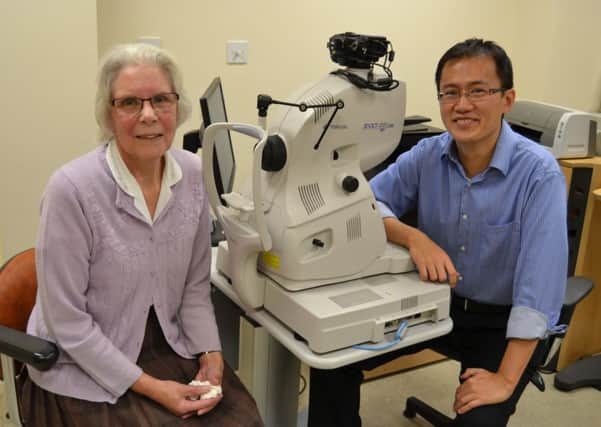Yapton woman’s sight restored by pioneering surgery


Daphne Moore, 75, from Yapton, was one of the first patients to benefit from a new surgery being pioneered by consultant ophthalmologist Mr Fook Chang Lam at Western Sussex Hospitals NHS Foundation Trust.
Daphne was struggling to cope as her condition – Fuch’s endothelial dystrophy – meant her eyesight became so poor she could not even see the optician’s eye chart.
Advertisement
Hide AdAdvertisement
Hide AdBut after undergoing the new procedure called Descemet membrane endothelial keratoplasty or DMEK, Daphne now boasts driving-level eyesight.
She said: “It’s so wonderful to have it done and be able to see again after so long. It has really made a new world for me, a new life.”
A day after the surgery, performed under aneasthetic at Worthing Hospital, Daphne’s husband, Colin, gave his wife some eyedrops.
Daphne said: “First I could see his shirt was lovely and white, and then I saw my husband’s face properly for the first time in years – it was just so wonderful.”
Advertisement
Hide AdAdvertisement
Hide AdColin added: “It’s just incredible and it has totally changed her life because she was really struggling with virtually no sight at all – everything was just a blur.”
The condition Daphne was suffering from results in the cornea degrading as the inner lining of the eye wears out. If untreated, near blindness results and the eyes can become very painful. Previously, the only solution was to have a full cornea transplant – a complex procedure carried out under general anaesthetic where recovery would take more than a year with further surgery and contact lens use often needed to ensure adequate vision is returned. However, following an eight-month scholarship abroad, funded by the Royal College of Ophthalmologists, Mr Lam has perfected the new technique with impressive results under the tutelage of its inventor, Dr Gerrit Melles of the Nethelands Institute for Innovative Ocular Surgery.
The procedure involves a sheet of cells thinner than a single human hair (the thickness of cling film) being inserted into the cornea through an aperture just three millimetres wide.
Apart from a more rapid recovery of vision, the procedure reduces the chance of a corneal graft rejection from ten per cent to less than one per cent and it returns patients to a level of vision not previously possible with older techniques. The new procedure is only available from a handful of centres internationally. The first two patients in West Sussex have already had their vision restored and many more operations have already been scheduled.
Mr Lam, who works at Worthing, as well as St Richard’s Hospital in Chichester, has been teaching other eye surgeons to perform the procedure at international conferences.